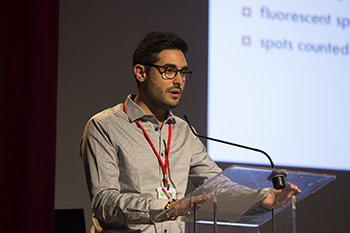Evaluation of the chemical contamination in the analytical control circuit of sterile injectable preparations
24 October 2018
L. Jordono 1, G. Bouguéon1,2, A. Berroneau1, S. Crauste-Manciet1,2 1 Pharmaceutical Technology Department, Bordeaux University Hospital (CHU de Bordeaux, France)2 ARNAChemBioPharm U1212 Inserm-UMR 5320 (CNRS Bordeaux University, France)

Background and Objectives
Chemical contamination when preparing cytotoxic drugs was extensively investigated. Nevertheless, few data are available considering chemical contamination risk associated to the analytical control of cytotoxic preparation [1]. The aim of our study was to evaluate the chemical contamination linked to analytical control.
Materials and Methods
Quinine sulphate, a sensitive and non-toxic fluorescent dye was used to replace cytotoxic drugs. Evaluation included all steps of the analytical control circuit from the sample preparation inside isolator to the final analysis by High Performance Liquid Chromatography (HPLC, Dionex) or QCRx (Icônes Services). From one 5g/L quinine bag, 60 samples were performed in the same conditions. 30 plastic vials (0.5ml) dedicated to HPLC and 30 glass vials (1ml) to QCRx. Each step was observed through an UV lamp to reveal quinine fluorescence and spots were counted (semi quantitative scale).
Results
After samples preparation, septum were contaminated at 86% for HPLC vials and 73% for QCRx. At the end of each series, surfaces of the isolator’s drape were contaminated with 39 and 13 spots for HPLC and QCRx respectively. After samples withdrawal in the output airlock, 34% of HPLC and 50% of QCRx vials presented a higher level of contamination (septum) and droplets were detected on the output airlock surface with 35 and 16 spots for HPLC and QCRx respectively. Once QCRx vials removing from isolator, 13 spots were detected on operator gloves, whereas none for HPLC. Surfaces of vials storage boxes nearby the analytical devices were also contaminated. Finally, after HPLC analysis 83% of vials presented a higher level of contamination (septum/cap) versus 53% (septum) after QCRx analysis.
Discussion-Conclusion
This work pointed out that analytical control can represent a source of chemical contamination for both operator and environment. To not disrupt the routine production, this work was performed apart from opening hours of the sterile production unit. The lower work flow induced could underestimate the level of contamination compared to routine production. It was not possible by this simulated method to determine if one of HPLC or QCRx was more at risk. However, it justifies our individual protection measures (i.e. use of disposable analytical vials and storage boxes, mandatory glove port with high frequency changes, and protection of surfaces with disposable plastic films of the computer’s keyboards). For high level of toxic drug production with high level of analytical control, dedicated containment areas should be envisioned.
[1] Crauste-Manciet S, Sessink P, surface contamination results- multicentre study for laboratory environments. 19th GERPAC Conference, 6-7 October 2016, Hyères, France